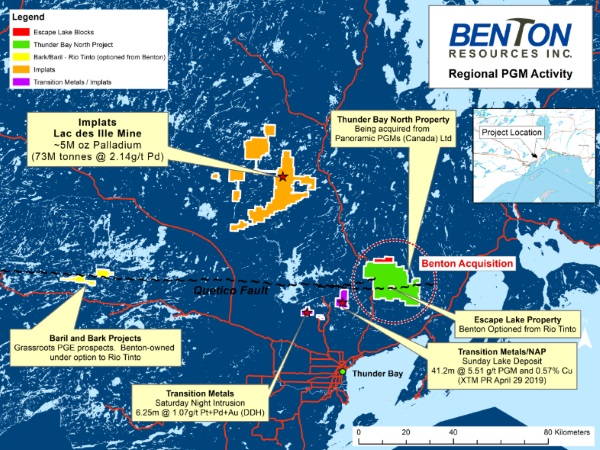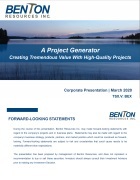Benton is pleased to announce that it has executed an option to joint venture agreement with Rio Tinto Exploration Canada Inc. on the Bark Lake project. Under the terms of the Option, Rio Tinto can earn a 70% interest by incurring $3 million in exploration expenditures and by paying Benton $50,000 cash over 5 years (the “First Option”). After the First Option period, RTEC may either form a joint venture with Benton on a 70/30 basis or, at its election, increase its interest to 80% (the “Second Option”) by spending an additional $5 million in exploration expenditures over 4 years and by paying Benton $100,000 cash within 30 days after electing to exercise the Second Option. Upon exercising the Second Option, RTEC may elect to form a joint venture with Benton on an 80/20 basis.

Property Location and Regional PGE Activity
Introduction
The Bark Lake property is host to a number of platinum (Pt), palladium (Pd), gold (Au), copper (Cu) and nickel (Ni) showings contained in mineralized ultramafic rock either in outcrop or dozens of mineralized boulders. The mineralized occurrences are situated along the Quetico Fault, a major crustal-scale east west oriented structure. Grab samples have returned grades up to 4.35gpt Pd, 2.64gpt Pt, 0.74gpt Au, 1.2% Cu, 0.5% Ni by Hackl Prospecting. Samples collected by Benton personnel have confirmed significant precious and base metals across the project area. More recent sampling has returned individual assays grading up to 1.5% Nickel, 1.2% Copper, 2.6 gpt Pt, 1.4gpt Pd and 0.7gpt Au. Twelve out of the 16 samples taken from the area returned results higher in Platinum than Palladium. Also of particular interest was the discovery of several semi-massive, net-textured sulphide boulders, with one measuring around 1 cubic metre in size and assaying 1.5% Ni. The boulders are angular in nature and believed to be located very close to source. In order to determine the source of the high grade boulders, Benton carried out an extensive exploration program on the property including linecutting, ground magnetics, ground IP, geological mapping and prospecting. The Mag and IP survey helped to define an ultramafic intrusion to the north of the property. Drill targets were defined based on the geophysical interpretation and Benton intersected the ultramafic intrusion in holes BL-08-04 and BL-08-05. Mineralization was present in these intersections but not to the same degree as in the boulders. Intersections were as follows:

The Bark Lake property consists of mining claims in the Boot Bay Area, Northwestern Ontario all of which are wholly owned by Benton.
Regional geology
The Bark Lake Property is underlain by ca. 2.690 – 2.698 Ga Archean Greenstone and Granitic rocks of the Quetico Subprovince and the Quetico Fault bounding the Wabigoon Subprovince to the north and Quetico Subprovince to the South (Percival and Easton, 2007). The Quetico Subprovince consists predominantly of meta-sedimentary rocks, derived migmatite and granite with a suite of Alaskan type mafic-ultramafic intrusions. These intrusions, called Quetico Intrusions, are commonly associated with the narrow meta-sedimentary belt that is wedged between the Quetico Batholith to the south and the Quetico Fault Zone to the north (MacTavish, 1999).
An early penetrative D1 fabric is prominent throughout the belt and predates emplacement of the Quetico Intrusions and calc-alkaline plutons (Percival and Easton, 2007). Subsequent deformation events were followed by low-pressure, high-temperature metamorphism that reached upper amphibolite to granulite facies at the center of the belt, and greenschist facies on the periphery (Percival and Easton, 2007). The belt was then intruded by late, crust derived granitic plutons and pegmatite dykes (Percival and Easton, 2007).
Property geology
During the Phase I drill program, three primary lithologies were encountered. Greenschist facies metamorphism is the predominant grade with a moderate penetrative fabric host in the meta-sediments and a weak fabric in the ultramafic rocks. Minor sulphide mineralization was encountered in drilling, However high grade mafic-ultramafic boulders hosting massive magmatic sulphide were observed during surface mapping. Property geology is as follows:
Greywacke/Meta-Sediments
This unit is light to medium grey-brown in colour, fine grain and exhibits a moderate to strong foliation. Foliation measurements taken during property mapping consistently gave an east-west strike, with dips ranging from nearly horizontal to vertical.
Mafic-Ultramafic Rocks (Quetico Intrusion)
Ultrmafic rocks were typically coarse grained pyroxenites with the occasional presence of biotite. Pyrrhotite was the most dominant sulphide mineral seen within the ultramafics with often lesser amounts of chalcopyrite and pyrite. This unit usually exhibited random grain orientation.
Orthogneiss
An orthogneissic unit was observed both in the field and in drill core. This unit ranged from fine grained up to pegmatitic. Composition consisted primarily of plagioclase with quartz, biotite and minor potassic feldspar. Sulphide mineralization was not seen in this unit. No mineral alignment was observed in most cases, although a weak foliation was occasionally observed.
Pegmatite Dykes
Pegmatite dykes were observed cutting the meta-sediment unit within drill core and in mapping. This unit is composed of large euhedral to subhedral crystals (1-10 cm) of hornblende, biotite, potassic feldspar with minor amounts of magnetite, quartz and carbonate.


